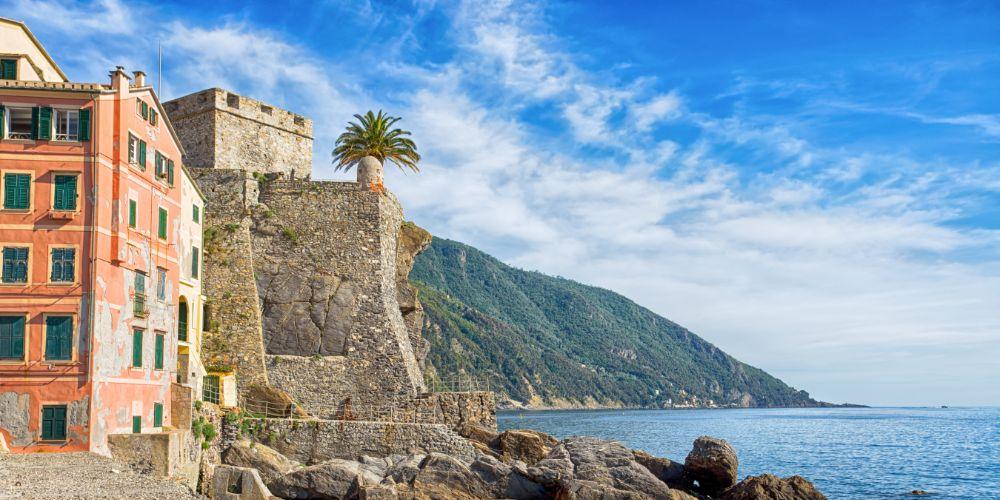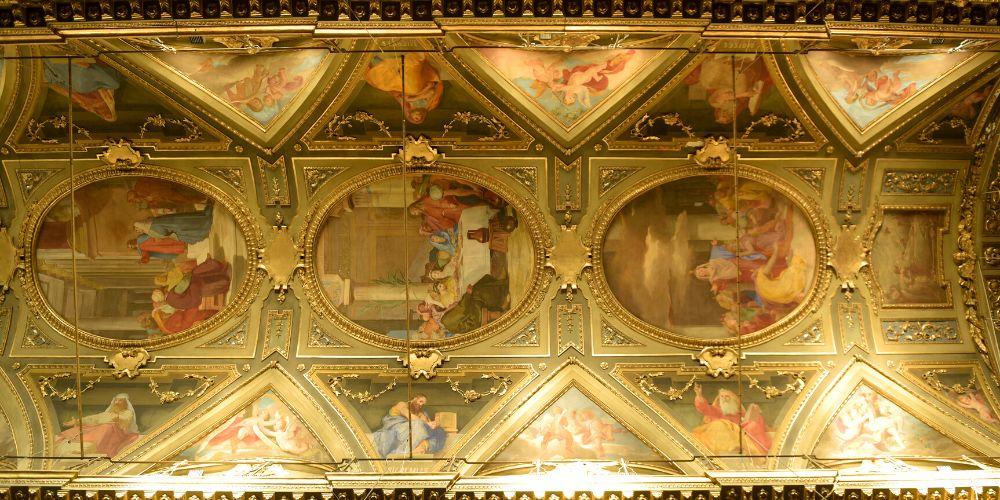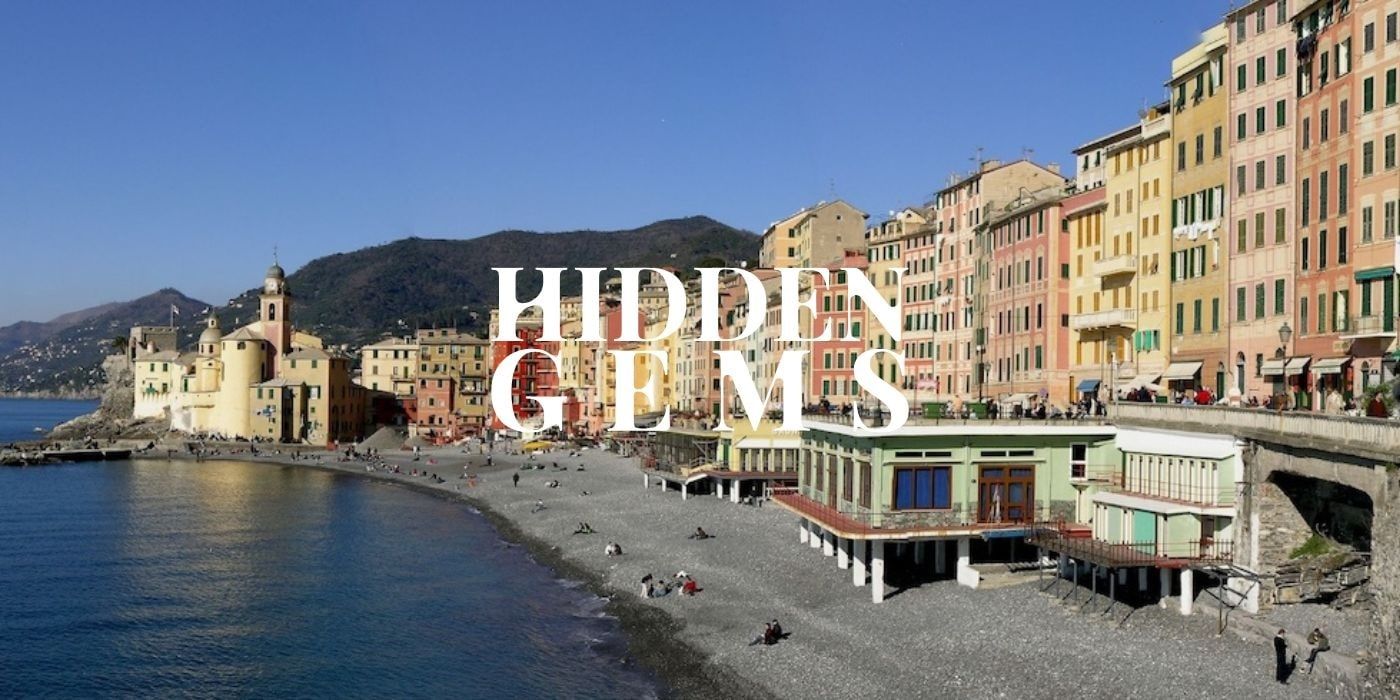Camogli, with its characteristic harbour, is one of the most beautiful villages in Liguria. It's located about 20 kilometres away from the "Superb" city of Genoa and will immediately impress you with its colourful buildings.
Camogli is a typical maritime village, known as "City of the Thousand White Sailboats". The centre of the village occupies the valley to the west of the Portofino mountain and overlooks the Golfo Paradiso, along the Riviera di Levante, to the east of Genoa.
Let's explore this beautiful, colorful village, ideal for relaxing moments with beautiful sea views.

Camogli, a gem in Liguria
If we want to spend a few days in Liguria, here is a beautiful gem that is absolutely not to be missed. Its images, with its multi-hued palaces built alongside the beach, Dragonara Castle and the Basilica of Santa Maria Assunta overlooking the sea, are an emblem of Liguria.
This village is also an ideal starting point for excursions around Genoa, including the Portofino Regional Natural Park. The paths through the park lead to hidden coves and offer breathtaking views.
From Camogli, we can also reach unexplored beaches and suggestive places such as the San Fruttuoso Abbey and Portofino by boat, appreciating the Ligurian coast from a different point of view.
Let’s go discover more together!
Camogli: historical notes

Camogli seen from the sea
The village of Camogli has prehistoric origins. This is proven by historical artefacts found after a series of excavations in the 1960s and 1970s. The finds date back to the 16th and 13th centuries BC. Other artefacts found in the same area date back to the 2nd century B.C., in Roman times.
With the rule of the bishops of Milan, around the year 1000, "coastal and maritime Camogli" began to form and Camogli began to be mentioned in texts of the time where it appears under the name Vila Camuli. In the 12th century, the Dragonara Castle was erected to defend the seaside village, which is still visible today.
In 1853, Camogli reached its greatest moment of glory, owning a fleet of over 500 boats, thus earning the appellation "City of the Thousand White Sailboats".
Things to do and see in Camogli

Camogli by night
The historical centre of Camogli is characterised by tall houses (reaching up to six floors in height) attached one to the other to take advantage of the little space available behind the mountain.
The buildings along the seafront have the most varied shades of colour, a typical feature of many seaside villages to make it easier for fishermen to recognise their homes.
Along the beach, close to the tall buildings there is the beautiful via Garibaldi promenade, lined with shops, restaurants and bars with outdoor tables. The promenade leads to the Basilica of Santa Maria Assunta.
Going further on, you reach the characteristic small harbour of Camogli, nestled between the colourful buildings, where fishermen's boats are moored.
The Dragonara Castle

The Dragonara Castle
Among the historical buildings there is the Dragonara Castle. The fortress was erected in medieval times in defence of the village and the coast, destroyed several times but then always rebuilt by the inhabitants of Camogli. In the 16th century, the castle was abandoned as a defensive post and was eventually used as a prison.
During the 1970s, after several decades of neglect, the manor was recovered and used to house the Tyrrhenian Aquarium.
The aquarium included several tanks containing seawater where specimens of marine fauna typical of Camogli's waters could find their natural habitat: a kind of ancestor of today's Aquarium of Genoa. In fact, when this small "aquatic museum" closed, the fish and crustaceans present were transferred to Genoa.
Visit the Aquarium of GenoaThe Basilica of Santa Maria Assunta

The Basilica's frescoed vault
The Basilica of Santa Maria Assunta stands on the ancient island, a large rock once detached from the mainland, where the original core of Camogli was concentrated. The castle also stands perched here.
According to historical sources, the Basilica, which can be reached from the small square in the nearby harbour by climbing a large flight of steps, dates back to the 12th century.
The exterior façade is very simple, while inside, there are three naves in Baroque style, covered in precious gold stucco and polychrome marble, with a frescoed vault from the late 19th century.
The side chapels and the vault are decorated with sculptures and paintings by artists of the Genoese school. On the high altar is a wooden statue of the Assumption, and inside the church is a precious organ from 1873.
Visiting the Basilica with all the lights on is impressive and conveys a sense of peace.
What to do in the surroundings of Camogli
Camogli is an excellent starting point for those visiting the Riviera Ligure di Levante, from Genoa to the Cinque Terre.
From here, we can also set off on various excursions into the Monte di Portofino Natural Park, a true paradise for nature and hiking enthusiasts with over 80 km of trails. We recommend a trip to the Bay of San Fruttuoso and its Abbey, a Benedictine monastery dating back to the year 1000, located in a unique venue, in the woods of the Portofino promontory.
It can be reached on foot via the trails starting from Ruta di Camogli — a fascinating route, though suitable only for experienced hikers — or, more comfortably, by boat. From Camogli, you can also continue by sea to explore the other villages scattered along the Gulf of Tigullio, such as Portofino, Santa Margherita Ligure, Moneglia and Sestri Levante.
Those who love the city and wish to get closer to Genoa will find experiences with a different yet equally captivating charm. Just a few kilometers from Camogli, seaside villages like Nervi and Boccadasse invite visitors to enjoy a relaxing afternoon with seaside walks and sunset aperitifs — the perfect prelude to discovering the lively nightlife of Genoa’s historic center.
How to reach Camogli
From the heart of Genoa, it takes only a few minutes to find yourself immersed in the peace and colors of the village of Camogli, overlooking the Gulf of Paradise. It’s easy to reach by car, train, or plane.
By car, the main route is the A12 motorway, with the exit at Recco. From there, continue toward Camogli for about 2 km. From the SS1 Aurelia, coming from La Spezia, turn toward Camogli after the town of Ruta; coming from Genoa, the turnoff for Camogli is in the center of Recco.
Traveling by train is very convenient: the arrival station is Camogli-San Fruttuoso, on the Genoa–La Spezia line.
- Travel time from Genoa: about 20 minutes
- Travel time from La Spezia: about 1 hour
- Travel time from Milano Centrale Station: just over 2 hours and 30 minutes
For those arriving by plane, the nearest airport is Genoa Cristoforo Colombo, from which Camogli can be easily reached by train or car.
About the author
Written on 24/09/2022



Sara Celin
A few kilometres from Genoa, on the Italian Riviera in Liguria, lies a small maritime village bursting with color: Camogli. Let’s discover it!